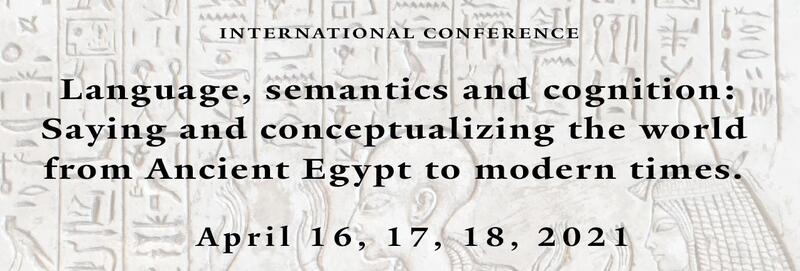Current conferences
UPDATE: The program is now available and registration is open!
- - - - - - - - - - - - - - - - - - - - - - - - - - - - - - - - - - - - - - - - - - - - - - - - - - - - - - - - - - - - - - - - - -

Introduction
In the last forty years, several breakthroughs have been made in applying theoretical frameworks from general linguistics to the study and description of the Egyptian language. One significant landmark was the organization of the first Crossroad(s) conferences in 1986 and 1990, which initiated an ever-growing trend. In the same theme, several studies have shown how valuable the insertion of ancient Egyptian data (and from other ancient languages) can be for the research in general linguistics, but also in cognitive and semiotic/semantic studies. However, the current state of research constitutes only a preliminary glance at what could be done in this research area. These are thus still very new and highly promising directions to investigate, especially with the recent development of digital corpora (on the Egyptological side: Thesaurus Linguae Aegyptiae, Ramses), which considerably ease the access to a large amount of data. These corpora allow for a more precise description of the underlying semantic structures of the Egyptian language as well as for easier and more systematic comparisons between languages.
This conference aims at first establishing and discussing the current state of research in the different fields involved (Egyptology, lexical semantics, semantic typology, visual semiotics, metaphor studies, cognitive linguistics, classifiers studies) and, second, at addressing some main research questions for the future in order to establish the foundations of a methodological road map for more effective interdisciplinary research.
Main research questions
- How can the study of Egyptian and other ancient languages and scripts contribute to cognitive linguistic studies?
- Reciprocally, how can theoretical frames from cognitive linguistics be used for/adapted to the study of ancient Egyptian and other ancient languages?
- What are the common points and differences that can be observed in world conceptualization cross-linguistically and cross-culturally? How are they translated at the spoken, written and visual levels?
- Can some recurring patterns be identified in terms of conceptual mapping? Are they culturally specific and/or do they have a more “universal” value?
- How far are the relations between conceptual level and linguistic/visual level symmetrical or asymmetrical? How transparent do the linguistic/visual manifestations of conceptual mapping appear cross-culturally? In other words, do we have (all) the keys to understand them?
- Can they be linked to semantic evolution dynamics (if so, to which extent)?
- In the case of Egyptian, to which extent can the two latter points influence classification strategies and their evolution in diachrony?
Themes
The main themes that will be addressed during the conference are as follows:
- physical world perception and categorization
- sensory perception
- emotions, personal characteristics and social interactions
- cognition-related lexicon and expressions (in general)
Research lines
These themes will be treated from the following approaches:
- intra-linguistic lexical semantics and semantic evolution
- semantic typology
- conceptual mappings (metaphors, in a broad sense: both conceptual and their formal realisation: linguistic and visual/written level)
- classifiers studies
- visual semiotics (e.g. relation between image and text)
Objectives
The first aim of the conference is to explore the link between the cognitive level (What are the conceptual categories in which the real is divided? How are they organized?) and the linguistic and written/visual level (How are these concepts expressed in the language/script?) in the frame of the themes mentioned above.
The second aim is to compare the results obtained from the different perspectives and approaches (cf. supra, research lines), and to highlight the differences and/or similarities that can be found cross-culturally and cross-linguistically, in ancient and modern times.
The third aim is to address the question of the advantages and limits of an interdisciplinary approach and to stress the importance of making data from ancient languages and scripts accessible in order to integrate them in the research in linguistics and semiotics.
Invited speakers:
Camilla di Biase-Dyson (Macquarie University)
Orly Goldwasser (Hebrew University of Jerusalem)
Maria Koptjevskaja Tamm (Stockholm University)
Cristina Soriano (University of Geneva)
Martine Vanhove (LLACAN)
Jean Winand (University of Liege)
Organizer:
Gaëlle Chantrain (postdoctoral associate and lecturer in Egyptology)
Visit me on Academia.edu
Program: Visit the program by clicking HERE.
Registration:Please use this link to register to the conference
